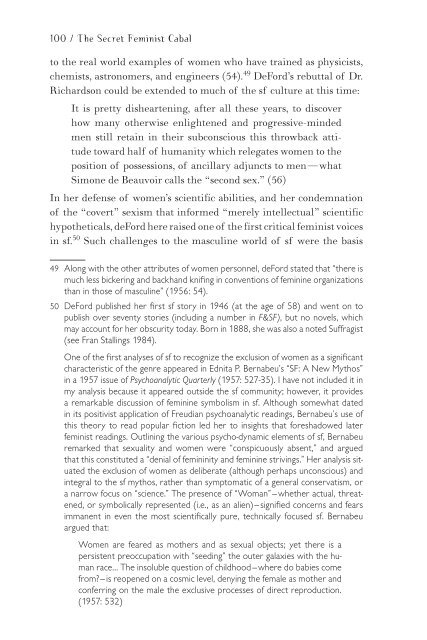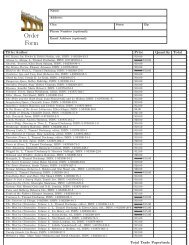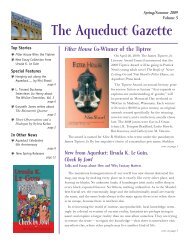Feminist Ca
Read Chapters Two and Three - Aqueduct Press
Read Chapters Two and Three - Aqueduct Press
- No tags were found...
You also want an ePaper? Increase the reach of your titles
YUMPU automatically turns print PDFs into web optimized ePapers that Google loves.
100 / The Secret <strong>Feminist</strong> <strong>Ca</strong>bal<br />
to the real world examples of women who have trained as physicists,<br />
chemists, astronomers, and engineers (54). 49 DeFord’s rebuttal of Dr.<br />
Richardson could be extended to much of the sf culture at this time:<br />
It is pretty disheartening, after all these years, to discover<br />
how many otherwise enlightened and progressive-minded<br />
men still retain in their subconscious this throwback attitude<br />
toward half of humanity which relegates women to the<br />
position of possessions, of ancillary adjuncts to men — what<br />
Simone de Beauvoir calls the “second sex.” (56)<br />
In her defense of women’s scientific abilities, and her condemnation<br />
of the “covert” sexism that informed “merely intellectual” scientific<br />
hypotheticals, deFord here raised one of the first critical feminist voices<br />
in sf. 50 Such challenges to the masculine world of sf were the basis<br />
49 Along with the other attributes of women personnel, deFord stated that “there is<br />
much less bickering and backhand knifing in conventions of feminine organizations<br />
than in those of masculine” (1956: 54).<br />
50 DeFord published her first sf story in 1946 (at the age of 58) and went on to<br />
publish over seventy stories (including a number in F&SF), but no novels, which<br />
may account for her obscurity today. Born in 1888, she was also a noted Suffragist<br />
(see Fran Stallings 1984).<br />
One of the first analyses of sf to recognize the exclusion of women as a significant<br />
characteristic of the genre appeared in Ednita P. Bernabeu’s “SF: A New Mythos”<br />
in a 1957 issue of Psychoanalytic Quarterly (1957: 527-35). I have not included it in<br />
my analysis because it appeared outside the sf community; however, it provides<br />
a remarkable discussion of feminine symbolism in sf. Although somewhat dated<br />
in its positivist application of Freudian psychoanalytic readings, Bernabeu’s use of<br />
this theory to read popular fiction led her to insights that foreshadowed later<br />
feminist readings. Outlining the various psycho-dynamic elements of sf, Bernabeu<br />
remarked that sexuality and women were “conspicuously absent,” and argued<br />
that this constituted a “denial of femininity and feminine strivings.” Her analysis situated<br />
the exclusion of women as deliberate (although perhaps unconscious) and<br />
integral to the sf mythos, rather than symptomatic of a general conservatism, or<br />
a narrow focus on “science.” The presence of “Woman” — whether actual, threatened,<br />
or symbolically represented (i.e., as an alien) — signified concerns and fears<br />
immanent in even the most scientifically pure, technically focused sf. Bernabeu<br />
argued that:<br />
Women are feared as mothers and as sexual objects; yet there is a<br />
persistent preoccupation with “seeding” the outer galaxies with the human<br />
race… The insoluble question of childhood — where do babies come<br />
from? — is reopened on a cosmic level, denying the female as mother and<br />
conferring on the male the exclusive processes of direct reproduction.<br />
(1957: 532)




